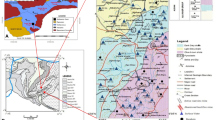Abstract
This paper assesses the role of intestinal helminth parasite of Macrobrachium vollenhovenii on host metal accumulation in Lekki lagoon, Lagos, Nigeria. Lead, zinc, copper, chromium and iron concentrations were determined in water, sediment, intestinal parasite, intestine of infected and non-infected prawns. Intestinal nematode parasite Cucullanus sp. was identified. Pb and Cr were not detected in the water and sediment. The sediment had higher concentrations of the metals than the water medium, and exceeded the WHO limits for Zn, Cu and Fe. Cucullanus sp. accumulated Zn 19 times, Cr several thousand times more and Fe 11 times more than the host intestine (wet wt). This parasite could have accumulated these metals from its host, reducing the concentration of these metals in the tissues of the infected prawns compared to non-infected ones. The infected and non-infected prawns accumulated Zn and Fe several times more than the water medium. The parasite influenced metal accumulation in the host tissue and pose ecological risk.
Similar content being viewed by others
References
Akinsanya B, Kuton MP, Saliu JK, Ukwa UD (2015) Host relative condition factor and prevalence of intestinal parasites of Parachanna obscura and Sarotherodon melanotheron as indicators of environmental stress in Lekki lagoon, Lagos. Niger J Life Sci 5(2):37–46
Ali M, Hau VTB (2001) Vegetables in Bangladesh: economic and nutritional impact of new varieties and technologies. Asian Vegetable Research and Development Centre (AVRDC) Technical Bulletin 25
Bergey L, Weis JS, Weis P (2002) Mercury uptake by the estuarine species Palaemonetes pugio and Fundulus heteroclitus compared with their parasites, Probopyrus pandalicola and Eustrongylides sp. Mar Pollut Bull 44:1046–1050
Bhatia SC (2010) Environmental chemistry. CBS Publishers and Distribution Pvt Ltd, New Delhi, 300 pp
Bruno DW, Nowak B, Elliott DG (2006) Identification of fish protozoan and metazoan parasites in stained tissue sections. Dis Aquat Org 70(1–2):1–36
Chien LC, Hung TC, Choang KY, Yeh CY, Meng PJ (2002) Daily intake of TBT, Cu, Zn, Cd and As for fishermen in Taiwan. Sci Total Environ 285:177–185
Kaoud HA, Eldahshan AF (2010) Bioaccumulation of Cd in Freshwater prawn Macrobrachium rosenbergii. Nat Sci 8(4):157–168
Lawal-Are AO, Morkwenye CR, Akinwunmi MF (2017) Heavy metal bioaccumulation in Callinectes amnicola and Farfantepenaus notialis from three selected tropical water bodies in Lagos, Nigeria. Ife J Sci 19(2):247–254
Li J, Zhiyong HY, Hu Y, Yang H (2013) Potential risk assessment of heavy metals by consuming shellfish collected from Xiamen, China. Environ Sci Pollut Resour 20:2937–2947
Mackenzie K, Williams HH, Williams B, McVicar AH, Siddall R (1995) Parasites as indicators of water quality and the potential use of helminth transmission in marine pollution studies. Adv Parasitol 35:85–144
Malek M, Haseli M, Mobedi I (2007) Parasites as heavy metal bioindicators in the shark Carcharhinus dussumieri from the Persian Gulf. Parasitology 134(07):1053–1056
Marcogliese DJ (2005) Parasites of the superorganism: are they indicators of ecosystem health? Int J Parasitol 35:705–716
Marcogliese DJ (2006) Parasites of spottail shiners (Notropis hudsonius) in the St. Lawrence River: effects of municipal effluents and habitat. Can J Zool 84:1461–1481
Pietrock M, Marcogliese DJ (2003) Free-living endohelminth stages: at the mercy of environmental conditions. Trends Parasitol 19:293–299
Rajaganapathy V, Xavier F, Sreekumar D, Mandal PK (2011) Heavy metal contamination in soil,water and fodder and their presence in livestock and products: a review. J Environ Sci Technol 4:234–249
Saliu JK, Akinsanya B, Ukwa UD, Odozie J, Ganiu Y (2014) Host condition, parasite interaction and metal accumulation in Tilapia guineensis from Iddo area of Lagos lagoon, Nigeria. Iran J Ichthyol 1(4):286–295
Saliu JK, Ukwa UD, Akinsanya B (2015) Malapterurus electricus (Gmelin, 1789), and its intestinal parasites as heavy metal biomonitors in Lekki lagoon, Nigeria. Niger J Life Şci 5(2):290–302
Shari Z, Soebarto V, Williamson T (2008) Proposed development of Malaysian sustainable building assessment framework. In: Proceedings of SENVAR and 2nd ISESEE 2008 international seminar in sustainable environment & architecture and international symposium & exhibition in sustainable energy & environment, Malaysia, 1–3 Dec 2008, pp 415–424
Sures B, Taraschewski H, Jackwerth E (1995) Cadmium accumulation in two adult acanthocephalans as compared with their fish host and Cd and Pb levels in larvae of A. Lucii as compared with their crustacean host. Parasitol Resour 81:449–451
Sure B, Taraschewski H, Rydlo M (1997) Intestinal fish parasites as heavy metal bioindicators: A comparison between Acanthocephalus lucii (Palaeacanthocephala) and the Zebra Mussel. Dreissena Polymorpha Bull Environ Contam Toxicol 59:14–21
Sures B, Siddall R, Taraschewski H (1999) Parasites as accumulation indicators of heavy metal pollution. Parasitol Today 15(1):16–21
Sures B (2006) How parasitism and pollution affect the physiological homeostasis of aquatic hosts. J Helminthol 80:151–158
Ukwa UD, Eyiaro T, Orji K, Bawa-Allah KA, Saliu JK (2015) Heavy metal accumulation in catfish (Malapterurus electricus, Chysichthys nigrodigitatus and Synodontis clarias) inhibiting the Lekki lagoon, Lagos, Nigeria. Niger J Fish 12(2):912–919
Ukwa UD, Saliu JK and Osibona AO, 2018.Combined effects of intestinal infestation and extrinsic stress on host energy in Malapterurus electricus host-parasite system in Lekki lagoon, Nigeria. Iran J Ichthyol 5(1): 43–54.
US EPA (1989) Risk assessment guidance for superfund. Human health evaluation manual (Part A), Vol 1, EPA/540/1–89/002
US-EPA IRIS (2006) United States, Environmental protection agency, integrated risk information system
Author information
Authors and Affiliations
Corresponding author
Rights and permissions
About this article
Cite this article
Bamidele, A., Lawal-Are, A., Iniobong, A.D. et al. Role of Intestinal Helminth Parasite of Macrobrachium vollenhovenii–Cucullanus sp. in Host Metal Accumulation in Epe Axis of the Lekki Lagoon, Lagos, Nigeria. Bull Environ Contam Toxicol 104, 222–227 (2020). https://doi.org/10.1007/s00128-019-02769-w
Received:
Accepted:
Published:
Issue Date:
DOI: https://doi.org/10.1007/s00128-019-02769-w




